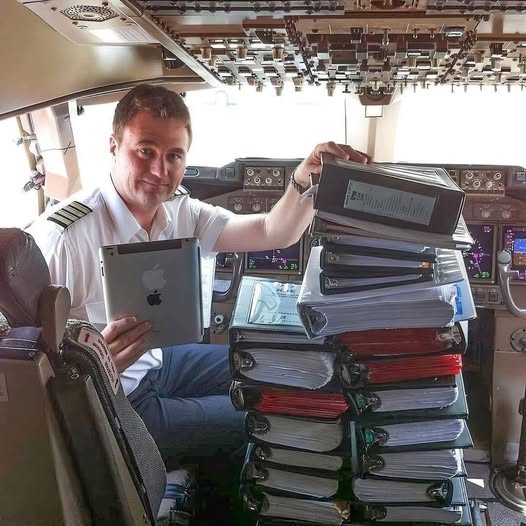
1. Efficiency and Real-Time Updates
iPads equipped with Electronic Flight Bag (EFB) apps like ForeFlight or Jeppesen provide pilots with instant access to navigation charts, weather data, and airport diagrams. Updates are delivered digitally, eliminating the need to manually replace outdated paper charts. For example, United Airlines saved 16 million sheets of paper annually by switching to iPads while ensuring pilots always have the latest information.
- Paper manuals: Require physical distribution of updates, which can lag behind real-time changes and create clutter in the cockpit.
2. Weight, Fuel Savings, and Environmental Impact
- iPads: A 1.5 lb iPad replaces ~38 lbs of paper manuals, reducing aircraft weight and saving 326,000 gallons of jet fuel annually for large airlines. This also lowers carbon emissions and operational costs.
- Paper manuals: Heavy stacks contribute to fuel inefficiency and environmental strain due to paper production.
3. Functionality and App Ecosystem
Modern iPads support specialized aviation apps that go beyond static charts:
- ForeFlight: Offers moving maps, ADS-B weather/traffic, and flight planning tools.
- Jeppesen Mobile FliteDeck: Provides interactive terminal charts and geo-referenced navigation.
- CloudAhoy: Logs flight data for post-flight debriefing.
These apps integrate GPS, weather overlays, and synthetic vision, enhancing situational awareness. - Paper manuals: Limited to static information without dynamic features like real-time weather or traffic alerts.
4. Reliability and Redundancy
- iPads: Require careful implementation. Best practices include:
- Using Wi-Fi + Cellular models for built-in GPS (no data plan needed).
- Carrying backup devices and external GPS units (e.g., Bad Elf Pro).
- Ensuring battery life meets flight duration (e.g., iPads last ~10 hours on continuous use).
- Paper manuals: Immune to technical failures but lack redundancy if lost or damaged.
5. Cost Considerations
- iPads: Initial investment includes the device (329–329–1,900), accessories (e.g., Apple Pencil Pro: 129),andapps(e.g.,∗ForeFlight∗subscription:129),andapps(e.g.,∗ForeFlight∗subscription:99–$299/year). Long-term savings from reduced paper/fuel costs offset this.
- Paper manuals: Lower upfront costs but incur recurring expenses for printing, shipping, and storage.
6. Pilot Workflow and Training
- iPads: Streamline workflows with searchable notes, annotations (via stylus), and split-screen multitasking. However, pilots must adapt to touchscreen interfaces and avoid distractions.
- Paper manuals: Familiar and distraction-free but slower to navigate during critical phases of flight.
Key Challenges with iPads
- Dependency on technology: Software bugs or failed updates can render devices unusable. The NBAA recommends restricting updates to 3–4 hours pre-flight and testing backups.
- Regulatory compliance: While Part 91 operators have flexibility, formal EFB programs (e.g., redundancy protocols) are advised for safety.
Verdict
iPads dominate modern cockpits due to their dynamic functionality, weight savings, and environmental benefits, but they require robust backup plans and training. Paper manuals remain a failsafe but are increasingly phased out as aviation embraces digital transformation. For pilots, the ideal setup combines iPads with redundancy (e.g., a second device or partial paper backups) to balance innovation and reliability.
Leave a Reply